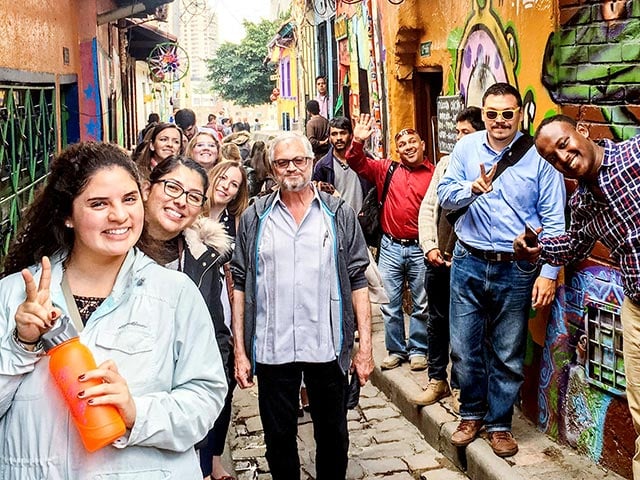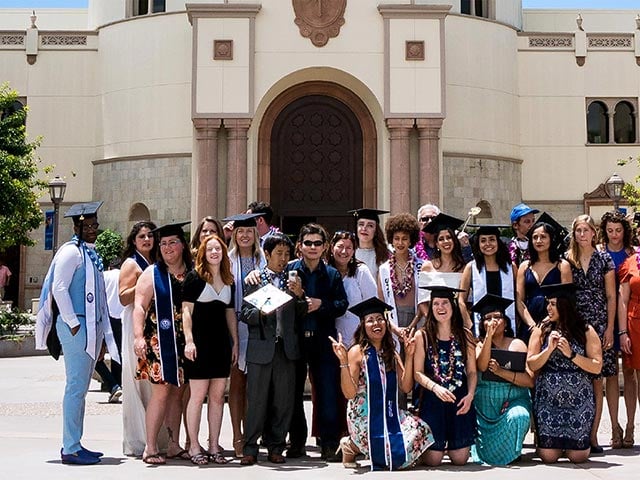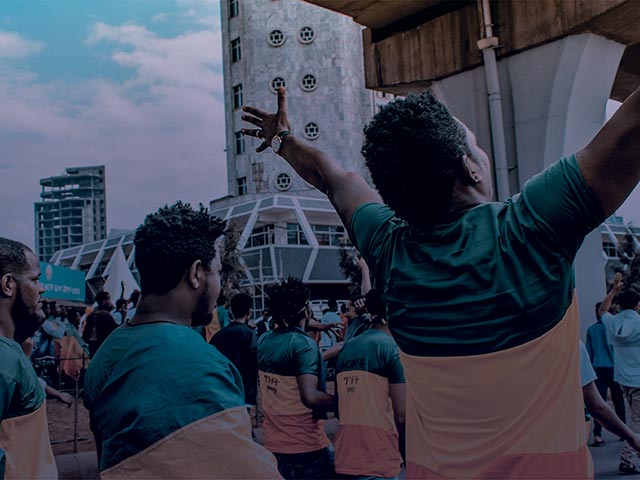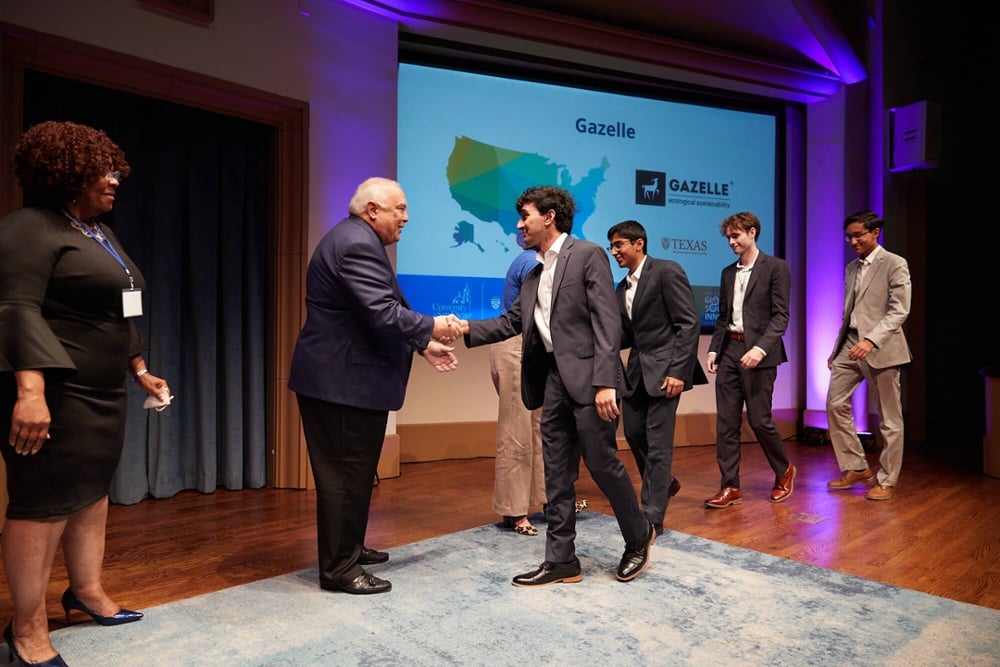What is Peace Work?
Table of Contents
Throughout most of recorded history, eminent people have inspired us by speaking of and promoting peace. Albert Einstein reminded us that "Peace cannot be kept by force; it can only be achieved by understanding." Eleanor Roosevelt told us that "It isn't enough to talk about peace. One must believe in it. And it isn't enough to believe in it. One must work at it."
In reality, “Working at it,” requires passion, drive, knowledge, experience and skills only a peace school can offer. It’s not just about ending unwanted situations, but about constructing new patterns, processes and structures that foster lasting peace.
We invite you to explore the concept of peace work, the essential components of peacebuilding and how you can become a leader in a field that needs you.
- 01 What is Peace?
- 02 Positive Peace vs. Negative Peace
- 03 Elements of Peace Studies Theory
- 04 An Introduction to Peace Work and Peacebuilding
- 05 Examples of Peace Work in the World Today Careers in Peace
- 06 Peace Education Opportunities
- 07 Start Your Path to Becoming a Peace Worker | Kroc School of Peace Studies
Negative peace: the absence of violence or fear of violence.
Negative peace is used to refer to the cessation of violent acts. This approach was inspired by the twin definitions of health. Negative health is curative whereas positive health is preventative. In the same way, relative to violence, negative peace is curative whereas positive peace is preventative.
Positive peace: the presence of attitudes, institutions and structures that create and sustain peaceful societies.
Positive peace is peace that is just and sustainable. Positive peace is the ultimate goal of peace work, as it aims to ensure that societies have the conditions in which all people can thrive. Developing social cohesion, relationships across groups and trust in institutions are all required for positive peace. After violence has ended, positive peace can only be achieved through rebuilding and social cooperation between sides previously in conflict.
Violence is often grouped into three main categories: direct, structural and cultural violence.
- Direct violence is the violence we physically perceive; war, rape, murder, assault and verbal attacks. It manifests itself out of conditions of structural and cultural violence.
- Structural violence occurs when social structures or social institutions harm people by preventing them from meeting their human needs. Disabilities, disparities and even deaths result when policies and institutions meet some people’s needs at the expense of others.
- Cultural violence occurs in the symbolic sphere of our existence; rhetoric symbols, flags, hymns and the history we tell. Johan Galtung defines “cultural violence” as “any aspect of a culture that can be used to legitimize violence in its direct or structural form.”
We can only address violence effectively if we are aware of the different ways people experience it and the social structures and cultural narratives that support it.
WHAT IS PEACE?
Peace may seem like a simple, black-and-white issue; either it exists, or it doesn’t. However, the reality is that peace is multifaceted and layered, and depends heavily on the perspectives and experiences of individuals or groups.
In short, peace is neither easily summarized nor is it easily sustained.
Historically, the term “peacebuilding,” or the work it takes to bring about and maintain peace, was first introduced in 1975 by Johan Galtung. John Paul Lederach later broadened the term to mean, “a comprehensive concept that encompasses, generates, and sustains the full array of processes, approaches, and stages needed to transform conflict toward more sustainable, peaceful relationships.” Peacebuilding both precedes and follows formal peace accords, yet it’s not a phase or condition, but a dynamic continuum of socially constructed transformations.
ELEMENTS OF PEACE
Studies Theory
Peace studies theory encompasses various theories that contribute to our understanding of how peace can be achieved and maintained.
Three significant theories often discussed are peacemaking, peace enforcement and peacebuilding.
Peacemaking:
Conflict takes no holidays and can appear at any moment. Peacemakers are the professionals who work to bring conflicting parties together at the bargaining table so they can reach a negotiated settlement.
Peace Enforcement:
When conflict has progressed to the point of violence, organizations like the The United Nations Security Council (UNSC) may approve coercive measures that can include military force. Restoring peace and security in the combative regions is the goal of peace enforcement.
Peacebuilding:
This may be the most productive example of peace work, but it's also one of the most difficult to achieve. Peacebuilding lays the foundation for positive peace. It strengthens the parties in conflict by shoring up national capacities that lay the foundation for sustainable peace.
According to the United Nations, peacebuilding “…is a complex, long-term process of creating the necessary conditions for sustainable peace. Peacebuilding measures address core issues that affect the functioning of society and the State and seek to enhance the capacity of the State to carry out its core functions effectively and legitimately.”
.png?width=600&height=360&name=Peacework%20Dove%20(1).png)
AN INTRODUCTION TO PEACE WORK AND PEACEBUILDING
Any survey of peace work is likely to include terms such as conflict prevention, mediation, conciliation, peacemaking, peacekeeping and peace enforcement.
Each of these represents an aspect of peace work, and they are mutually reinforcing. Peace workers achieve the best outcomes when these activities are performed together to address the root causes of conflict and thereby reduce the risk of conflict recurring.
Conflict prevention
involves proactively identifying and addressing potential sources of conflict before they escalate into violence, thus laying the groundwork for long-term peace and stability.
Mediation
serves as a method of conflict resolution, involving the assistance of a neutral third party in facilitating negotiations and dialogue between conflicting parties to reach a mutually acceptable agreement.
Peacekeeping
involves the deployment of impartial military or civilian missions to support the implementation of peace agreements and maintain peace in post-conflict environments, often with a focus on protecting civilians.
Peacemaking
focuses on actively negotiating and brokering peace agreements between conflicting parties to bring an end to the violence and establish a framework for long-term peace.

EXAMPLES OF PEACE WORK IN THE WORLD TODAY
Scholars and peace workers have defined peace work in a variety of ways. The Strategic Peacebuilding Pathways model put forth by John Paul Lederach and Katie Mansfield is one of many models, and it stands alongside those from the United States Institute of Peace, the United Nations and others. However, no matter which definition one prefers, all of them identify at least these three outcomes peace workers strive for.

-
Peace workers prevent, respond to and transform violent conflict. For instance, conflict mediators help individuals, groups and organizations resolve disputes and deal with conflict by equipping them with communication tools, conflict resolution mechanisms and other peacebuilding tools. Conflict mediators are an integral part of a healthy community as they help to de-escalate problems and facilitate interactions, conversations and behaviors that lead to lasting peace.
-
Peace workers ensure justice and healing, which is crucially important if positive peace is to be established. For example, World Renew focuses much of its peace work on gender justice, which means “more girls complete their education, remain single throughout childhood and gain access to leadership development in their own communities.”
-
Peace workers facilitate structural and institutional change. Building a foundation that supports positive peace often calls for significant changes to the social structure or institution. The need for structural and institutional change becomes obvious when the current social environment causes harm by preventing people from meeting their basic needs. For instance, when food, water or shelter become scarce in a given area but are readily available elsewhere in the region or the world, then structural violence is taking place.
But initiatives for peace can be found everywhere. In this way, we can see how many areas of our world need us, but we can also see the people who step up
to respond:
Transitional Justice Initiatives: Organizations such as the International Center for Transitional Justice (ICTJ) work to address past human rights violations and promote restorative justice in post-conflict societies. Through truth and reconciliation processes, reparations programs and institutional reform, they aim to heal societal wounds and establish a foundation for lasting peace.
Community-Based Conflict Resolution: Local peacebuilding organizations often focus on facilitating dialogue, mediation and reconciliation at the community level. These initiatives play a critical role in addressing grievances, rebuilding trust and fostering social cohesion within conflict-affected communities.
Restorative Justice and Reintegration Programs: Efforts to reintegrate former combatants into society and provide opportunities for rehabilitation and reconciliation are integral to the peace process. Organizations working in this area contribute to healing and rebuilding social bonds, reducing the risk of renewed violence.
Interfaith and Interethnic Dialogue: Promoting understanding and cooperation among diverse religious and ethnic communities is crucial for building peaceful and inclusive societies. Initiatives that foster dialogue and collaboration across religious and cultural divides contribute to social harmony and conflict prevention.
CAREERS IN PEACE
Peace and justice professionals are needed in a variety of sectors and at institutions around the world. Salaries and growth opportunities depend on the scale of the organization, the job market where the organization is located, and its funding sources, among other factors. There may be differences between salaries in international organizations and national and local nonprofits. There are also many pathways for moving between sectors, from the local to the international or from the government to the NGO sector.
Conflict Mediator
Average Salary: $71,540
These professionals help individuals, groups, and organizations resolve disputes and deal with conflict by equipping them with communication tools, conflict resolution mechanisms, and other peacebuilding tools. Conflict mediators are an integral part of a healthy community as they help to de-escalate problems and facilitate interactions, conversations, and behaviors that lead to lasting peace. Conflict mediators, make an average of $71,540 per year.
Program Officers
Average Salary: $79,553
These professionals are responsible for the implementation of specific programs in an organization. For example, international NGOs such as World Vision or Red Cross may have a program officer who leads initiatives focused on mitigating violence against women in disaster zones, or who implement programs for child protection. Other program officers serve as headquarters-based liaisons for field staff in different countries. Depending on the type of organization, program officers are usually mid-tier professional positions making $79,553 on average each year.
Development Manager
Average Salary: $168,545
In many organizations, such as 350.org, development managers are responsible for marketing and public relations activities directed at raising funds. They may be the sole contributor leading fundraising activities, or they could lead a team. These professionals may also be responsible for creating and managing special events or publications designed to maximize donor engagement. In the United States, development manager salaries are $168,545 on average per year.
Restorative Practitioner
Average Salary: $57,500
Restorative justice emphasizes repairing the harm caused by violent behavior through cooperative processes that allow all willing stakeholders to meet and agree upon a restoration plan. Restorative justice professionals focus on trauma healing, conflict mediation, facilitating restorative justice dialogues and much more. Salaries for these positions can vary greatly. For example, a restorative justice coordinator working at a school makes, on average, $57,500, while a mid-career practitioner makes more.
UN Civil Service Officer
Average Salary: $68,000
According to the UN, “Civil affairs officers are a key civilian component that helps facilitate interactions between peacekeeping missions, partners and local communities to prevent conflict. Civil affairs work depends on a mission’s mandate and the evolving situation on the ground.
Three constant key activities that civil affairs officers undertake are engaging local stakeholders, participating in local conflict management and supporting the extension of state authority. In 2020, 565 Civil Affairs officers in eight UN Field Missions played a key role in early warning and situational awareness of conflict dynamics on the ground.”
The salary range for a mid-career field service officer is $44K - $68K before additional compensation based on the position post. Entry-level professionals earn between $21K-$54K and senior-level professionals earn between $56K-$90K.
Human Rights Defender
Average salary: $84,269
Individuals in these positions investigate complaints of human rights violations and protect at-risk populations. They may also be involved in community conversations to address injustices or serve as mediators. On the front lines, a human rights defender with an organization like Human Rights Watch can make between $71,213 and $300K per year.
PEACE EDUCATION OPPORTUNITIES
The Kroc School of Peace Studies at the University of San Diego offers a range of academic programs that empower you to become an effective peacebuilder and agent of positive social change.
-
Master's in Peace and Justice (MAPJ)
The MAPJ program at the University of San Diego's Kroc School of Peace Studies is #3 Best Value Peace Studies & Conflict Resolution Master’s Degree. It’s also the #5 Best Peace Studies Master’s Degree. The MAPJ program equips you with the knowledge and skills to become an effective peacebuilder and agent of positive change.
You'll engage in interdisciplinary coursework, experiential learning and gain a global perspective.
- Modality: In-person, on-campus classes
- Term length: 24 months, with an accelerated 9-month option available
- Start dates: New cohorts start in fall and spring
-
Master's in Social Innovation (MASI)
The MASI program is the #1 nationally-ranked social innovation master's program. It prepares you to drive social change through innovative and entrepreneurial approaches. You'll focus on social entrepreneurship, design thinking and impact evaluation.
- Modality: In-person, on-campus classes
- Term length: 15-24 months, with flexible, part-time schedules available
- Start dates: New cohorts begin in fall, spring and summer
-
Flex Master's in Conflict Management and Resolution (MSCMR)
The MSCMR program equips you with the skills and knowledge to address and resolve conflicts at all levels, from interpersonal to international. You'll focus on negotiation, mediation and conflict analysis.
- Modality: Hybrid, with a blend of online and short on-campus residencies and immersive sessions
- Term length: 15-24 months or within 6 years, if part-time
- Start dates: New cohorts start in the fall and spring
- Certificate: The program also offers a certificate option.
-
Juris Doctor (JD) and Master of Arts in Peace and Justice (MAPJ) Dual Degree
Being the #1 nationally ranked peace and justice master's program, the Juris Doctor (JD)/MAPJ dual degree program at the University of San Diego allows you to earn both degrees simultaneously. You'll engage in an interdisciplinary curriculum combining law and peacebuilding, with opportunities for experiential learning.
- Modality: In-person, on-campus classes
- Term length: 4 years with flexible, part-time options available
Start Your Path to Becoming a Peace Worker

Peace studies is a crucial field that aims to promote understanding, nonviolence and sustainable peace in our world challenged by conflicts and social injustices.
Pursuing a career in peace work is not only intellectually stimulating but also deeply rewarding; it allows you to make a meaningful impact on the lives of others and contribute to creating a more just and peaceful world.
While the challenges facing our global community may seem daunting, each of us has the power to play a role in creating positive change. Whether through direct involvement in conflict resolution initiatives, advocacy efforts or community-based peacebuilding projects, every action counts.
If you're unsure which path to take, take our quiz to help explore your interests and find the program that best aligns with your goals!
If you have any questions about the Kroc School's programs or the admissions process, we can help! Schedule a time to speak with an admissions counselor or request more information about the school or a specific program.
The Kroc School of Peace Studies at the University of San Diego is committed to empowering the next generation of peacebuilders and social innovators, and our programs offer a unique opportunity to be part of this transformative mission!











